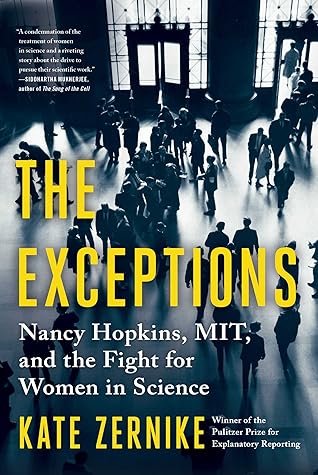More on this book
Community
Kindle Notes & Highlights
by
Kate Zernike
Read between
January 20 - February 3, 2024
Nancy saw how small facts from individual experiments added up to larger insights that together could answer the big questions. She began to see the elegant logic of biology; it was profound, mysterious, and yet totally sensible.
Rossi was a decade older than Lotte and had studied under Lotte’s father at Columbia. Now also a mother of three, she had been content holding positions as a research assistant at three different universities, most recently at the University of Chicago, where her husband was a professor. Then she was told that as a research assistant she could not submit a grant proposal to the National Science Foundation. She asked a male faculty member if he would submit it under his name. He did—then took the money, took over her project, and fired her.
She liked to remind young women that she had taken off only five days to deliver her three sons and advised her graduate students with what one thought of as Millie’s Quantum Theory of Babies: “You must have either two or four kids for a stable family life because kids are like electrons in an atomic orbital. They come with spin up and spin down, so you need to have a stable configuration. You can’t have one or three kids because that would be unstable.”
Professional science was figuring out how to get paid for making discoveries: writing grants to buy equipment and pay grad students and postdocs, publishing papers and speaking at scientific conferences to get “exposure” in the field, winning tenure, teaching, managing a lab. It was a job “constructed by and for men (a certain type of man),” she wrote. Someone with a wife at home to manage life outside the lab, and with supreme self-confidence.
In Sayre’s telling, Nancy saw a woman who was more sympathetic—and familiar. Franklin was intense, uncompromising, determined—“because there was something important to be determined about.”
Jim became the villain in the Rosalind Franklin story. But Sayre did not entirely blame him. She recognized that Franklin’s photograph on its own did not lead Watson and Crick to their famous discovery; it was one piece of the puzzle. What offended Sayre was that Watson’s telling had robbed Rosalind of her true personality. He had warped her to create a familiar stereotype, casting her as the “wicked fairy” in a cautionary tale about a bright woman who dares to think there is a place for her in science.
In this world, men were naturally geniuses, while women could only hope to work hard, and risk being ignored, minimized, or ripped off. “This slow and gentle robbery,” as Sayre called it, continued past the theft of Rosalind’s photograph. Museum exhibits and encyclopedia entries about DNA failed to mention her. Linus Pauling, another of the competitors in the race to understand DNA, had written a commemorative essay giving the credit for Franklin’s photograph and analysis to Wilkins.


